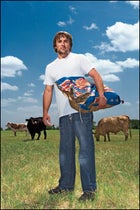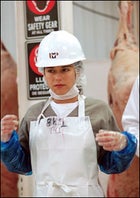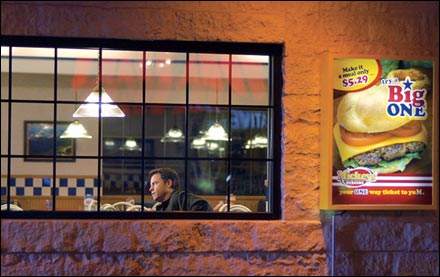FORGET “WHERE’S THE BEEF?”it’s what’s behind the beef that matters to Richard Linklater. The Austin, Texasbased director, who’s spent his career alternating between edgy cult favorites (Dazed and Confused, A Scanner Darkly) and big-budget popcorn flicks (School of Rock, Bad News Bears), takes a bold leap into nutrition politics this month with Fast Food Nation, a fictional interpretation of Eric Schlosser’s 2001 muckraking assault on pit-stop dining franchises. Linklater and Schlosser’s collaborative screenplay used the research-rich book to conjure multiple narrativesa burger-chain executive (Greg Kinnear) sent to investigate rumors of feces in the meat supply, a Mexican illegal immigrant who’s braved a border crossing for sweatshop shifts at a meat-processing plant, a fast-food clerk desperate to escape her greasy giginterwoven to create an almost hopelessly grim and gruesome fable. The film boasts star power, with cameos by the likes of Ethan Hawke, Bruce Willis, and Patricia Arquette, and promises a shocking yuck quotient, thanks to a scene shot on the killing floor of a real slaughterhouse in northern Mexico. Steven Kotler grills the auteur about his last meal and America’s coming diet war.
Richard Linklater
 Linklater in Austin, August 2006
Linklater in Austin, August 2006Fast Food Nation
 Scenes from FAST FOOD NATION: Mexican immigrants loading up for an illegal border crossing.
Scenes from FAST FOOD NATION: Mexican immigrants loading up for an illegal border crossing.Fast Food Nation
 Scenes from FAST FOOD NATION: Inside a meat-processing plant
Scenes from FAST FOOD NATION: Inside a meat-processing plantOUTSIDE: Your film focuses on everything you think is wrong with the fast-food industry. What’s the one essential fix that needs to be made right now?
LINKLATER: God, there are so many. If the film awakens anything in anyone, I hope it’s a general awareness of where fast food comes from and the true costs behind its production. Once you peek inside that world, it’s fairly obviousin terms of the animals, the environment, the sustainability, and the health of the individual consumerthat the system is broken. Sure, the end result is cheap and fast, but the production of it is anything but. There is no one fix. It’s way too big for that.
So should we just scrap the whole industry and start over?
Fast food is a really efficient model, but the companies need to offer more healthy choices. Healthier drinks, healthier food, whole-wheat breadjust up the quality. I’ll say this for the record: If McDonald’s put a really healthy, decent-tasting veggie burger on their menu, I would drive through and buy one every now and then. And if five million other people agreed to do the same, we might actually see some change.
I take it you don’t currently eat fast food.
Actually, I just had lunch at a place I consider fast food here in Austin called Mr. Natural. It’s vegetarian Mexican food, cafeteria style. You go in and four minutes later you’re eating.
@#95;box photo=image_2 alt=image_2_alt@#95;box
What about poor working families? Don’t the fast-food franchises offer them affordable and easy meals?
That is a problem when you’re working two jobs at minimum wage, and I guess it’s a triumph that the system can feed so many people: You can buy that cheeseburger for a bucknot that it’s healthy. But there are other options. I’ve been a vegetarian since 1983, and now is actually a great time to be one. For $1.29 at most grocery stores, you can buy Health Valley couscous and lentils, which is like a healthy version of ramen noodles. Stuff doesn’t have to come from Whole Foods and cost a lot to be good for you. It’s not nearly as complex as people think.
By converting a densely reported book into a fictional film, you’ve left yourself vulnerable to claims that you’ve vastly exaggerated the situation.
We left out most of what was in the book, but what I hope we captured is its spirit and its atmosphere. The film is a dramatization, but through this fiction we’re getting at a lot of truth. It’s not based on one particular incident. What we’re saying is that it’s so pervasive. I can assure you it all goes on all the time.
Do you wish you’d made a documentary instead?
No, this is the film Eric and I wanted to make, and I wouldn’t change a thing. But it’s just a beginning, not some A-to-Z primer. We resisted doing a traditional narrative where some Shane-style hero comes in to right every wrong, because if there was ever a system that couldn’t be fixed by one individual or film, it’s this one. It would have been morally bankrupt for us to say, OK, this system is broken, so here’s how you fix it. This film is just a first shot in what I hope is a much bigger war.
It seems like Hollywood is suddenly obsessed with political filmmaking. What’s the deal?
It’s in the air everybody’s breathing right now. Things are fucked up, and I actually think the entertainment industry is a pretty good little weather vane for that. Before, you never got the financing. Now there’s this idea that people might respond, so you might get something made that you wouldn’t have ten years ago.
How are the fast-food franchises reacting to the movie?
It’s a little early to tell. A lot of what we’ve seen so far has been spin campaigning directed at Eric, because he’s been on their list a long time and because of his latest book, Chew on This, which is kind of a Fast Food Nation for kids. There were some things reported in The Wall Street Journal about a “truth squad” launched by McDonald’s. But we’re really not in the thick of it yetthey’re not going to show their plan too early.
This is new territory for you as a filmmaker. Are you ready for the backlash?
It’s healthy and challenging to find yourself in the crosshairs of someone you’ve offended or threatenedI don’t mind it at all. I’ve floated through life as a concerned citizen, a concerned parent, who’s never had to articulate much beyond my feelings. The industry hires lobbyists and has laws written in their favor, and I’ve gone after their bottom line. When that’s threatened, you get zinged by the best of the bestthe guys on the debate team who always won and then went to law school and now get paid to represent really powerful interests.
@#95;box photo=image_2 alt=image_2_alt@#95;box
The film contains some pretty tough scenes to watch. Which was the hardest to shoot?
Physically, it was the day in the desert, when we shot the scene of illegal immigrants sneaking across the border. We were filming just south of the New Mexico border, it was really hot, and we had 53 setups in one day. Everything you see in the desert we did in one day. We went out there when it was dark and we left when it was dark. It was that kind of movie, you knowwe just had to run and gun all along.
Filming in a slaughterhouse couldn’t have been easy, either.
We were wearing what the workers wearhard hats, gloves, bootsand it’s cold in there. I don’t know which was worse, the moment the cow gets the bolt gun in the head or seeing the skulls thrown into piles. But it’s not chaotic at all. It’s chillingly systematic and efficient. After it was over, I remember calling Eric and saying, “You know, I felt like a war correspondent today.” Like I’d captured something that we all know happens, that’s a very common thing but not something that’s seen very often.
Is the ick factor the most powerful part of the movie?
When Upton Sinclair wrote The Jungle back in 1906, he thought people would be aghast at the plight of the workers. But what really got to them was the fact that they were potentially eating rancid food that had been on the factory floor. It’s the same today. Even the richest, most uncaring people think, I don’t want my loved ones to get sick.
How about the cast and crew? Did they all decide to become vegetarians?
While we were shooting the slaughterhouse scenes, a lot of people said they wouldn’t eat beef for a while. But, sure enough, a lot of them walked right outside and over to this big wok where our caterers were grilling up meat.
1. Heading Into Action
You’re dashing out of town for a day or afternoon of high-energy fun.
You Need: Sustained fuel, which means a lot of everything. Aim for a breakdown that’s 50 percent carbohydrates and 25 percent each protein and fat.
Beware: High-fiber breakfast cereals that offer only a low-calorie dose of carbsyou’ll end up bonking after a few hours. Also, be careful with yogurt and especially greasy meat, which can be tough to digest and slow you down.
Meal Plan: Get waffled. Or pancakedboth are loaded with carbohydrates and fat.To assemble an ideal power breakfast at IHOP, Denny’s, or any diner: 1. Go light on the syrup. 2. Skip the extra butter. 3. Say yes to fruit and nuts. 4. Order your eggs poached. 5. If you must have breakfast meat, make it ham.
2. Eating for Recovery
You’re drained after six-plus hours of intense play and need a quick refuel before the long drive home.
You Need: Carbsthe most important part of a recovery mealfollowed by protein, then fat. All three are necessary for replenishing energy stores, repairing damaged muscles, and keeping you alert.
Beware: Loading up on fat that will fill you up before you get enough carbs and protein. Make this mistake and you’ll need three to four days to recover instead of one or two.
Meal Plan: Big-picture issues aside, burger chains provide what your body needs. At Wendy’s, order two hamburgers, a baked potato with chili, and a small Frosty. This Shaq-size meal is just 1,250 calories, with only 29 grams of fat… that is, if you can bear to hold the mayo on the burgers and cheese sauce on the potato.
3. Traveling Light
You’re stuck eating an entire day on planes and in airports.
You Need: Lighter foods that are filling enough to keep you from being tempted by a (fluffy, delicious) Cinnabon.
Beware: Greasy gut-loaders (pizza, chow mein, and burgers), which are packed with calories and fat that you don’t need on an inactive day. Also avoid in-flight sodas and salty snack mixes, which will leave you bloated and thirsty.
Meal Plan: Look for pre-packaged salads and deli sandwiches… Wait a minute, you arrived three hours before your flight, so why are you rushing? Sit down at TGI Friday’s for the Bruschetta Tilapia, with rice and broccoli, or at Chili’s for the Guiltless Chicken Platter, with rice, corn on the cob, and steamed veggies. But skip the 20-ounce latte, which has 270 calories260 more than black coffee.


